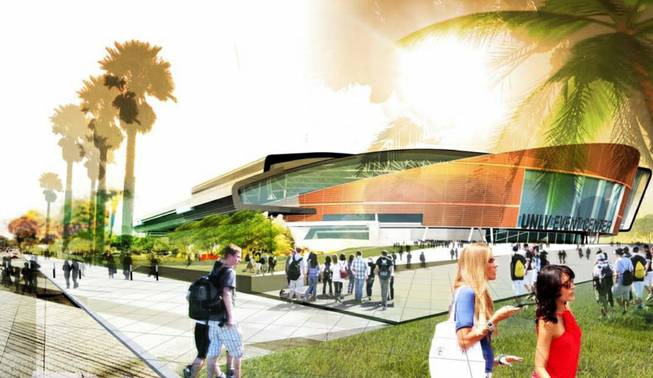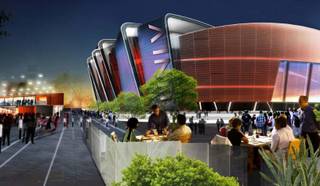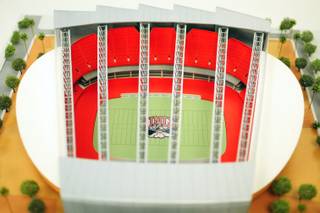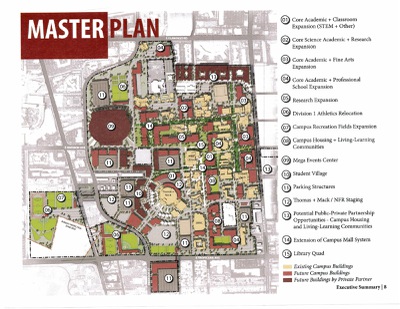
Majestic Realty Co.
A rendering of the UNLV Now mega-events center.
Saturday, Jan. 19, 2013 | 2 a.m.
Related content
More on stadiums
- Take a closer look at stadium proposals in and around Las Vegas in the Sun's Racing to build Vegas' next venue report from July 15.
The developers’ latest presentation on UNLV Now, the proposed $800 million, 60,000-seat mega-events center, has certainly increased the buzz about the transformation of the UNLV campus.
Although I’ve heard from some skeptics, most of the response on the message boards and talk-radio shows has been positive. As a lifelong resident of Las Vegas, I’m cautiously enthusiastic about the project because of the tremendous impact it will have on our city.
But one thing is sure: Everyone has questions about it. Here is a sampling, with some answers.
There have been several arena and stadium projects pitched through the years for Las Vegas. What are the chances this will really be built?
The simple fact this proposal is for the UNLV campus gives it a legitimate chance. More important, several influential people in town — people who have roots here and understand the need for the facility — support UNLV Now. Other projects have been proposed by outsiders and have had questionable planning, giving them no true chance. For instance, developer Chris Milam’s plans for an arena on the Strip or behind the M Resort, which he also claimed included a NBA team relocating to Southern Nevada, were unrealistic. But past plans shouldn’t give a black eye to the solid planning behind UNLV Now. Majestic Realty, led in this effort by Craig Cavileer, Silverton resort president, and the Board of Regents understand how UNLV Now would change the landscape of the university. The stadium would be the centerpiece of the UNLV campus, bring great prestige to the Rebel football program and produce cash — a study estimates the center would produce $393.2 million in new, direct spending annually for Las Vegas’ hospitality sector — some of which ultimately may be funneled into academic programs and research.
What will make this stadium special?
Las Vegas is known for its world-class resorts, and the fully enclosed events center follows along those lines. Designed by Woods Bagot, the same architecture group that designed the Staples Center in Los Angeles, the proposed UNLV Now has all of the bells and whistles you’d expect of a modern facility. (Take a look at the renderings — they are downright impressive). The centerpiece of the stadium is a 100-yard-long video screen — similar to the one at Cowboys Stadium in Dallas but 40 yards longer — that will be visible from 80 percent of the stadium’s 60,000 seats. It would be the largest video screen in the world. Plans also call for smaller video screens in the stadium’s four corners. Additionally, the stadium would feature two clubs, six 300-seat VIP suites and 50 conventional suites that seat 10 to 24 guests.
Who’s going to pay for it?
Developers are looking for financing three ways: long-term naming rights and advertising (about $270 million), a tax-increment financing plan that needs approval in February from the Nevada Legislature, and revenue the facility would generate. It would not take money from any of the university’s academic programs. The arena reportedly will cost $800 million; Majestic will release its cost estimate to regents Feb. 22 during a public workshop on the project.
What stands in its way?
Officials describe the next six months as the project’s “critical phase” because of the approvals they need to secure. If all goes well, they could break ground in the next two years and open the arena by 2017. If not, the project could lose momentum and be spiked. The most important approval will come from the Nevada Legislature during its 120-day session that starts next month. It’s arguably the most significant 120 days in UNLV history. If lawmakers don’t approve the tax-increment finance district, the Legislature wouldn’t be able to take up the issue again until it meets again in 2015. Approval of the TIF district would exempt developers from paying property, sales and live entertainment taxes generated by UNLV Now for an estimated 25 to 30 years, instead allowing them to collect those taxes to pay off the debt. Additionally, developers will try to secure monetary pledges from casinos, which don’t necessarily have the reputation of being generous, and from the Las Vegas Convention and Visitors Authority. And, of course, an economic agreement between the Nevada Board of Regents and Majestic Realty needs to be signed. I’m always nervous when elected officials from Southern and Northern Nevada are asked to vote on something that would directly benefit Las Vegas. Let’s call it a bad hunch: I hate relying on the North.
Where exactly on campus would the facility go?
It’s planned for the current site of the UNLV baseball facility, north of Harmon Avenue and east of Swenson Street. (Click here for the map).
So, then, what’s going to happen to Earl E. Wilson Stadium (home of UNLV baseball)?
The baseball complex would be moved south, between Harmon and Tropicana avenues. In November, the Clark County Commission agreed to sell 60 acres there to the university if the UNLV Now project is approved. UNLV has never reached a College World Series, but a new stadium — just like the benefits of the mega-events center — would be an upgrade Rebel baseball desperately needs. UNLV could potentially host regional and super regional events in the NCAA Tournament, offering an invaluable home-field advantage in the journey to the CWS in Omaha.
What events will be held at UNLV Now?
Officials had a long list of possibilities during their presentation to regents — some of which you can argue are overly ambitious. A study done by the University of Michigan estimates the arena will bring $393 million annually to the Las Vegas hospitality sector with 15 annual events — not including UNLV football home games. Here are the ones that seem most realistic: Mountain West Conference and Pac-12 Conference football championship games, concerts after the National Finals Rodeo (which will stay at the Thomas & Mack Center), UFC and boxing fight cards (bye, bye Cowboys Stadium), a BYU football neutral-site game and music festivals. Other suggestions likely fall into the category of “if you build it, they will come.” Those include a Major League Soccer franchise, an NFL exhibition game or the Pro Bowl, and a Bowl Championship Series playoff game.
What about parking and traffic? That’s a lot of folks to get in and out of campus — not to mention getting to the airport.
This is the most popular criticism of the project and something developers definitely need to address. A traffic study is under way. Plans call for a parking garage. Some traffic would be on foot coming from the Strip. There also would be shuttles from the Strip. I wish I had a better answer for this and, like you, have my doubts on how parking will work. However, a little traffic every now and then wouldn’t be the end of the world, especially when you consider the revenue any large events bring to town — taxi drivers and service industry employees would see a spike in their tips.
Why build this for UNLV football, when it struggles to draw even 10,000 fans?
First, and most important, this is not a stadium solely for UNLV football. It’s a mega-events center the Rebels will call home. Regardless, it’s a big-time score for the program, sending a message nationally that UNLV is serious about its team. Rebel football is a sleeping giant. Students rarely attend games at Sam Boyd Stadium because of transportation difficulties, but with the on-campus stadium they likely would have a significant presence at home football games. Plus, folks will show once the team starts winning, and the new stadium gives the football program the ability to quickly transform into a winner.
What about UNLV basketball? Are there plans to make over the Thomas & Mack Center? Will the Rebels play at the new arena?
The Rebels’ basketball team will continue to play at the Thomas & Mack, which isn’t scheduled for upgrades. With a capacity of 18,500, it is one of the largest college basketball arenas in the nation. UNLV Now can accommodate the basketball team on special occasions, but that hasn’t been suggested.
Ray Brewer can be reached at 990-2662 or [email protected]. Follow Ray on Twitter at twitter.com/raybrewer21.





Join the Discussion:
Check this out for a full explanation of our conversion to the LiveFyre commenting system and instructions on how to sign up for an account.
Full comments policy